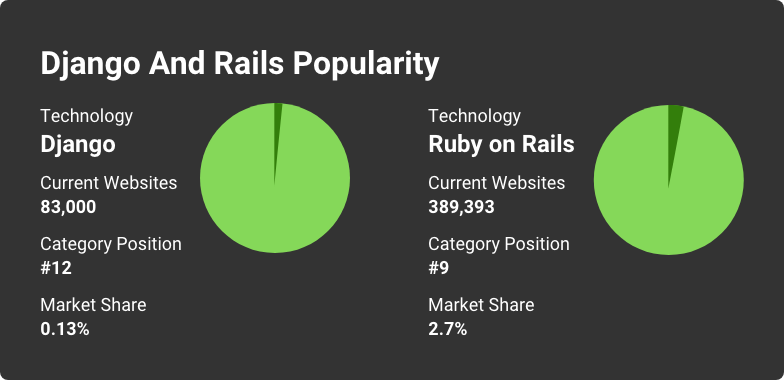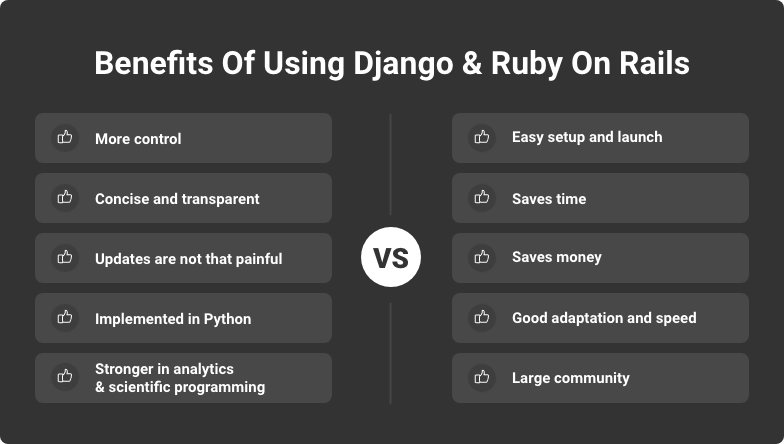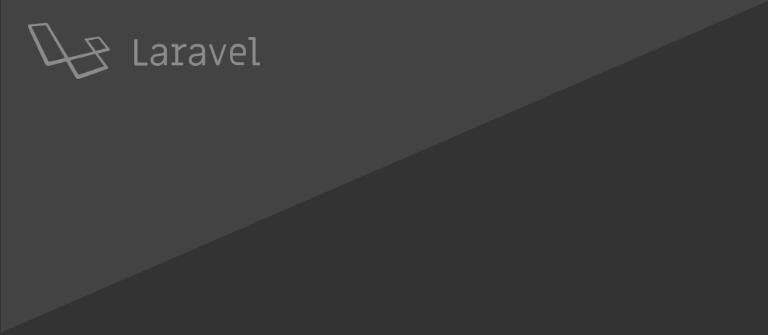Today we are going to compare Rails vs Django! Basically, these are two well-made web frameworks for web development that have a lot of similarities from the programming perspective. Rails comes from Ruby and Django comes from Python. They are both dynamically-typed, object-oriented languages. But the performance of Ruby on Rails vs Django depends on the projects where they are implemented. On some measures, you can say that they are like twins. The only difference between the two is the language under the hood, their philosophies, and the ecosystem.
Let's take a look at their histories to understand them better!
What Is Django Framework?

Django is a Python-based framework that originated in 2005 with the primary purpose of speeding up news site development. These days, this tool is used to achieve numerous other goals. The framework was used to build favorite apps, such as Pinterest, Instagram, and Bitbucket.
This web framework provides built-in ORM, Authentication, Admin UI, Session management and is available under a 3 clause BSD license. Django has a simple learning curve. Thus it’s comprehensive and user-friendly for beginners.
What Is Ruby on Rails Framework?

The framework was released in 2008 and gained popularity quickly. Ruby on Rails powers many popular websites, such as Fiverr, GitHub, Basecamp, and Airbnb.
As of 2019, 8.2% of developers worldwide claimed to be using Rails due to its powerful basic toolkit, which can be used by a developer to build a database-driven app. The main principle of Rails is “convention over configuration.” With Rails, you don't have to write as much code as you do in Django. Ruby on Rails is available under an MIT license.
Which Framework Is More Popular: Django or Rails?
According to the latest survey conducted by StackOverflow, Django is used by 14.2% of the developers (42,279 total respondents) while Ruby on Rails by 7%.
Even though Ruby on Rails is over 10 years old, numerous developers continue to choose this framework. It is perfect for small-scale projects, allows code optimization and horizontal scalability, and is excellent for social networking apps. In fact, based on Google Trends, the world of IT has shown a consistent interest in Ruby on Rails.
Let’s examine the some recent data:

As you can see, Ruby is in the top 10, while Django holds only the 12th position. 300,000 more websites have been built with Rails than with Django. The data from the past month shows that Rails has been extending that lead:
Ruby on Rails - 6,304 new sites
Django - 1,228 new sites
Rails added 5 times more new websites last month than Django.
Websites dropped over the past month:
Ruby on Rails - 4,062 sites dropped
Django - 890 sites dropped
This paints quite a similar picture. Rails was dropped by 5 times more websites than Django.
Overall, the net change for the month has the total number of websites using Rails growing by 2,242 and the total number of websites using Django growing by 338.
If we focus on the tendencies inside the web frameworks ecosystem (websites added vs websites dropped), we see that Rails has a 2.5% growth rate and 98.4% retention rate compared to a growth rate of 2.3% and retention rate of 98.3% for Django.
Despite the similar growth and retention rates, Rails currently has a small edge in overall popularity, holding 3.3% of the market share, while Django holds only 0.68%.
Difference Between Ruby on Rails and Django
Since every project is unique and has customized needs, it is essential to pay close attention to the framework’s characteristics when investigating a technology’s popularity. While one can be more suitable for small-scale projects, another may prove to be spotless for large and complex projects. A properly chosen framework will considerably save you time and costs. So, let’s compare Django vs. Rails.
Productivity
The level of performance between both frameworks is quite similar. If you compare Bitbucket (which is based on Django) and Github (which is based on Rails), you'll notice that they are equally fast. If speed is your biggest concern for your website, there is no significant difference between Ruby on Rails and Django.
Architecture
The architecture of both Rails and Django is based on a well-structured MVC model (Model-View-Template in Django).
Django’s MVT goes through a Regular Expression-based URL Dispatcher that establishes what app users see and interact with. Ruby on Rails MVP identifies database data, including pictures, posts, and other visual components.
Security
In the Django versus Rails comparison battle, security is a primary factor to consider.
One of the most popular types of intervention used by perpetrators is XSS attacks. This is a malicious code that is embedded in pages, replacing certain data on websites. For example, it can change links to lead a user to the intruder's site or insert harmful ads. Quite often, such pieces of code remain passive for a long time, which prevents its detection. Such attacks can be disastrous because they could also be used to take a user’s money. Django templates already have built-in filters that protect against most types of harmful inputs. The only thing that remains to do is to strengthen their actions. With Ruby on Rails, not everything is so rosy. XSS attacks are the most common type of violation of the integrity of a site written with this framework. And this behavior can destroy the entire web service. Thus, sites developed on ROR require third-party solutions.
Another type of attack is cross-site request forgery (CSRF). This helps one user to perform actions on behalf of another user without consent. Django has tools to identify and prevent most of these types of attacks. Ruby also has some built-in protocols for protecting prototypes, but its developers recommend taking additional safety measures.
Among all hacker attacks, Clickjacking is perhaps the most harmless. Its essence is to redirect users to another site automatically. The purpose of such attacks is usually to increase traffic to third-party resources. Django has a standard module called X-Frame-Options that prevents clickjacking. Ruby's logic works a little differently. To be protected against such attacks, developers must add the “X-Frame-Options: SAMEORIGIN” HTTP header to the site’s pages.
Syntax
The syntax is a set of rules described by symbols that are part of a running program. Each programming language has its own syntax. The Python syntax is pretty straightforward and makes it suitable for most projects. This is beneficial when a developer must be replaced or added to the project, and the new team member needs to understand the existing code as quickly as possible.
Many people call ROR syntax elegant. Indeed, to write the same command on Ruby, you need fewer lines of code than on Django. However, the readability of the code on the Ruby framework is more complicated. Thus, a new member of the team will need more time to investigate the project.
API
API are third-party programs that are executed by your website or application. For example, all built-in payment systems are API. There are also internal APIs that allow different components of the system to communicate with each other. Python has Django’s REST framework, which makes it easy to develop third-party applications.
Comparing Ruby on Rails vs. Python, it is worth noting that the first does not have REST technology. That means that creating an API on ROR is very complicated and depends on the programmer’s skills. This tilts the API issue in favor of Django, making the development process simpler and more affordable.
Want to build a startup or expand your business? We will provide you with high-quality and timely project development. KeyUA is your reliable assistant in the world of web technologies.
Contact UsDevelopment principles
Django allows building complex database-driven web applications and websites quickly, while Ruby on Rails is suitable for modern database-backed web apps.
When it comes to development principles, let’s look closer at their peculiarities.
The Django benchmarks:
Reusability
Fast development
Easy to write and read the code
Explicit is better than implicit
DRY (Don't Repeat Yourself)
The Rails way:
DRY
ActiveRoad pattern
Codes are shorter and cleaner
Convention over configuration
Installation
Django is quicker to install and can take just a few seconds. It requires a created virtual end then running a pip install command. Rails takes a little longer to install. First, you have to install bundle and gem, and then run the gem install rails command.
Third-party libraries
For Django, there are plenty of third-party libraries and lots of platforms available for free to help you learn about them. We recommend Django Packages. It is tough to find a better one if you are looking for Django Apps. Unfortunately, Rails is not supported by such a hidden treasure.
Learning curve
The learning curve is steep for Rails. Because you have to pick up a lot of independent concepts, using a seasoned programmer is highly recommended. Meanwhile, you can learn Django a bit faster due to the code’s better readability, so it is a good choice for beginners.
Community and support
The Ruby community is highly developed. Programmers from all over the world support each other on various blogs and Youtube channels. Of course, Django also has a vast team of fans. But it is believed that the ROR community of programmers is more advanced. At the same time, many note the extremely detailed Django documentation. It is no doubt a factor as to why the Django community is less developed. Python's papers are very understandable, allowing even a novice to understand the syntax quickly.
Notable open-source projects
Django:
Bootcamp. Bootcamp is a simple concept of an enterprise social network with a simple feed app on the front page, similar to Twitter.
Parsifal. Parsifal is a tool that performs systematic literature reviews that require a huge amount of time from the researcher.
Bloodhound. Bloodhound is another web-crawler whose purpose is tracking and indexing price movements on retail stores daily.
Ruby on Rails:
Discourse. Discourse is a simple platform for simple communication, which can be used as a discussion forum or a mailing list.
Spree Commerce. Spree Commerce is an open-source platform that can be used to build online storefronts. Some well-known brands like Lavazza, for example, use this platform.
Refinery CMS. Refinery CMS is a content management system that offers elegant out-of-the-box solutions. It is available for free and supported by a large community.
Fat-Free CRM. Fat-Free CRM is a customer relationship management platform that provides automated sales processes. It handles managing contacts, lead tracking, customer databases, and quotes.
Ruby on Rails or Django: Final Comparison
For your clear understanding, we have gathered all information about both frameworks into one table. It will help you make an efficient and cost-effective decision for creating a competitive product.
Comparison Factor | Django | Ruby on Rails |
Syntax | One way for debugging and reading | Extremely Flexible |
Security | Backed with Middlewares | Has Active Records |
Installation | Easy | Gems and Bundle required |
Speed and Performance | Convenient due to REST feature | Fast due to plugins and rich libraries |
UI | Excellent due to plugins and add-ons | Excellent due to plugins and add-ons |
Architecture | Model-View-Template | Model-View-Controller |
Usage | Allows developing complex database-driven apps and websites | Mainly for database-backend web applications |
Learning Curve | Easy to learn | Sharp |
Django vs. Ruby on Rails: When Should You Use It?

You can go with Django if your team prefers the Django philosophy, works with Python, and believes that documentation is your best friend. It is also the right decision if you have to work with Python libraries, like machine learning apps, etc.
Benefits of Using Django
By choosing the Django framework, you can build highly customized apps and websites. Moreover, due to the code’s reusable features, you don’t need to create new ones for different projects, thus saving you time and costs. Let’s see what else.
More control when choosing configuration options and layouts
Concise and transparent
Most updates are not that painful or frequent compared to RoR
Python resembles the English syntax
Stronger and more useful in areas such as analytics, scientific programming, data manipulation, and system administration
Benefits of Using Ruby on Rails
Ruby on Rails has ready-to-use solutions, an extremely logical interface, and is perfect for back-end web application development.
CoC (convention over configuration) philosophy - well-made, structured layout with defaults that you can easily get up and running
Pattern-matching characters in syntax and differing characters used as an analog to keywords
Good adaptation and speed
Large community both offline and online
Wrapping up
The choice of the necessary programming language is usually dictated by the latest trend and the desire to make a quality product. Both Django and ROR are great web frameworks that have advantages and disadvantages. However, it is worth emphasizing that with Python, performance is higher. This means that a search on your site will be faster. Additionally, Python is a simple and interesting programming language. Its syntax allows any developer to quickly understand the code and study the project. And this can be very important when you need to meet deadlines. Built-in Django tools also provide more protection modules than Rails. Your site and data will always be reliably secured if you decide to use Python. Besides, such well-known services as Instagram and Pinterest are written on the Python framework.
The KeyUA team uses various programming languages and frameworks, but focuses mostly on Django. After all, it has already shown its productivity and effectiveness. Our programmers have extensive experience in developing platforms, online stores, and APIs in Python. We also monitor the quality of knowledge, so we are constantly studying new information, trends, and features in web development.
Depending on your business, we will develop secure project architecture and convenient functionality. Our team cares about customers, therefore we guarantee perfect programming solutions.








 Unit 1505 124 City Road, London, United Kingdom, EC1V 2NX
Unit 1505 124 City Road, London, United Kingdom, EC1V 2NX

Comments
Leave a comment